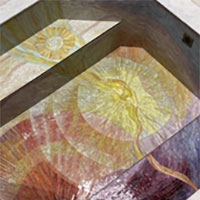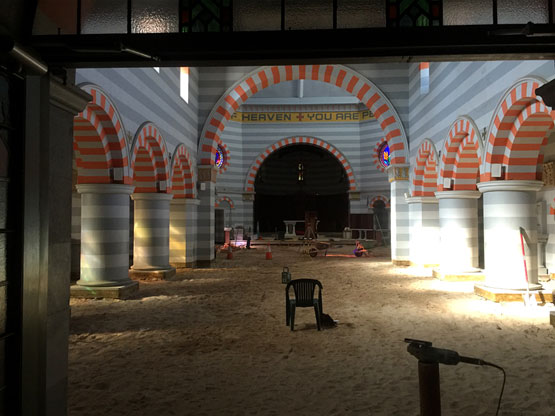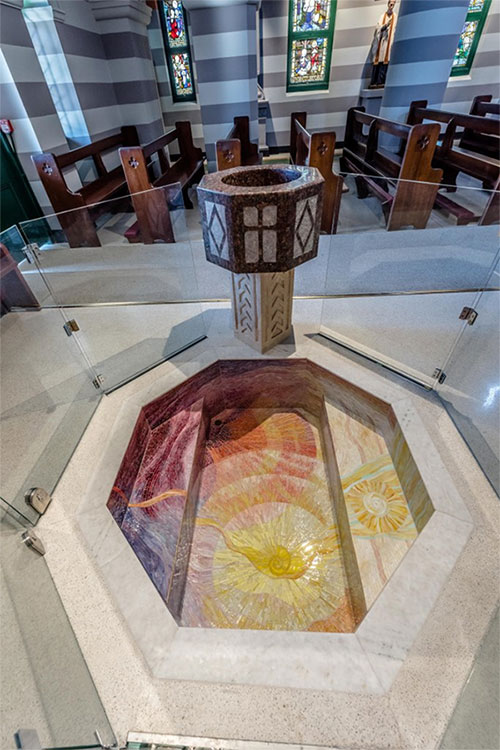 The inspiration of St Francis Xavier Cathedral in Geraldton, Western Australia, considered by some as one of the finest cathedrals built in the 20th century[i], can be found in the Arts and Crafts Movement of the late 19th and early 20th centuries. Among the principles of the Arts Crafts Movement is engagement of local builders, artists and crafts persons in the construction and decoration of buildings and the use of vernacular materials.
The inspiration of St Francis Xavier Cathedral in Geraldton, Western Australia, considered by some as one of the finest cathedrals built in the 20th century[i], can be found in the Arts and Crafts Movement of the late 19th and early 20th centuries. Among the principles of the Arts Crafts Movement is engagement of local builders, artists and crafts persons in the construction and decoration of buildings and the use of vernacular materials.
Respecting these principles, the liturgical furnishings committee of the Cathedral Precinct Project, consisting of Dr John Taylor, Dr Angela McCarthy, Rev Dr Paul O’Donnell and Rev Robert Cross, looked to commission a Western Australian artist to produce a mosaic for the cathedral’s proposed baptism immersion pool and to incorporate local materials as far as possible.
With this in mind, Fremantle based artist Dawn Meader was commissioned in 2017 to design and create a mosaic for the baptism immersion pool as part of a $10 million Cathedral conservation and enhancement project.

Dawn Meader’s studio and home is located in the port city of Fremantle, which in many respects is mirrored in the port city of Geraldton 400kms to its north, including the light, colour, sounds and smells one encounters in busy port cities.
What was asked of Dawn was to produce a mosaic for the floor (that later extended to its sides and steps) of the baptismal immersion pool that picked up on the rich symbolism of Baptism and the tapestry of colour and symbols extant in Hawes’ Cathedral. An element of the baptismal pool was the inclusion of a font built to a Hawes design and made from local granite and limestone (fig.1), that would also double as a holy water stoup. This would stand on the central aisle side of the immersion pool and act also as a holy water stoup.
Dawn was briefed on the key baptismal symbols of the eternal circle that symbolized God, the Trinity of Persons, the outpouring of divine grace and the waters of Baptism. A scallop shell was also suggested to be incorporated into the design to symbolize both the pouring of the living waters of Baptism, eternal life and pilgrimage, as well being a visual link to Geraldton’s maritime tradition.
Dawn was asked to orientate the mosaic from west to east as the Cathedral itself is and to make the immersion pool octagonal, a number that is symbolic of Christ and visible in other elements of the Cathedral’s architecture, notably its dome and lantern (or oculus).
Hawes always commenced his architectural designs around the contingencies of the site. In the design of the baptismal pool, the contingencies of the site, space and time imposed itself on the artist, artistically, physically and emotionally.
Having familiarized herself with the person, spirit vision and works of John Hawes, Dawn visited the cathedral prior to commencing work on the mosaic to meditate on site and to take in the place and its spirit. This meditation conveyed the simplicity of the design and art of the Cathedral, and yet there were strong and imposing elements like the stripes and colours.
As she wandered and contemplated the space of the Cathedral, whose concrete floor at that time had been removed to expose the barren sand hill on which the Cathedral was built (fig.2), Dawn noted it was as if the Cathedral had “. . . risen straight out of the earth . . .” and she recalled “. . . there was an overwhelming strong presence of love.”
Dawn then noticed light from the Cathedral’s stunning stained-glass windows “. . . cast its coloured glaze on the sandy floor . . .” She said, “The stained-glass windows were casting these beautiful pools of colour on to the ground with the softness that you get with that translucence of light. I wanted the person being baptized to be held, nurtured by the light.”

Inspired by this palette of colour and experience, Dawn literally retreated for a week to meditate on her experience and the Christian symbols around Baptism. From this, slowly and meticulously, with personal passionate emotional investment, emerged Dawn’s amazing and unique 24,000 hand cut and bevelled stained glass pieces mosaic that enthrals the many thousands of visitors who come from around the world every year to marvel at John Hawes’ creation now so sensitively enhanced by Dawn Meader’s stunning baptismal immersion pool mosaic (fig.3).

The immersion pool comes to life in the sacramental celebration of Baptism – the whole is greater than the sum of its parts. Above the immersion pool is located a three-tiered circular pendant, whose circles of light reflect on the waters of the immersion pool and penetrates deep to merge with three radiating bursts of light where the moment of Baptism happens. Like a bolt of lightning from west to east, a streak of light moves through the mosaic from west to east, from darkness to bright light, illuminating the pilgrim’s way.
CHRIST OUR LIGHT! THANKS BE TO GOD!
Rev Robert Cross
Director of Heritage, Diocese of Geraldton
Dawn Meader
Born in Kent, United Kingdom, Dawn arrived in Australia in 1985 and graduated from Claremont Art School in 1989. Dawn had previously been a nurse.
Dawn describes her art style as spiritual realism. Transformation and light have been a continual inspiration for her work and art teaching practice in Australia, Bali and India. Colour and light in paint, mixed media or stained glass is her visual dialogue.
Dawn has exhibited in solo and group shows over the past 30 years with mostly private and some public commissions, including the mosaic in St Francis Xavier Cathedral, Geraldton and a mural at Mandurah Hospital. She has worked as artist in residence with Beehive Montessori to create murals and published a book titled “The Nature of Love”, a collection of poems and paintings that explore love.
For more information visit www.dawnmeader.com
[i] Cruwys, E. & Riffenburgh, B., Cathedrals of the World – A Magnificent Guide to the Greatest Houses of Christian Worship, AA Publishing, Basingstoke, 1997, pp.184 – 185.

